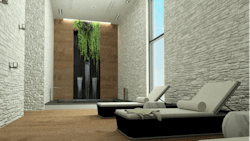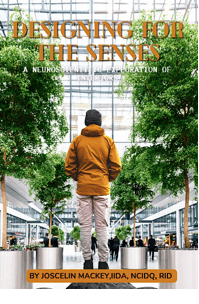New Book Explores Connection Between Neuroscience and Interiors
In a world where our surroundings profoundly impact our mental and emotional well-being, a groundbreaking new book, “Designing for the Senses: A Neuroscientific Exploration of Interiors,” by Joscelin Mackey, NCIDQ, RID, is set to redefine how we think about interior design. This exploratory work delves into the intricate marriage between neuroscience and interior design, offering a holistic exploration of how our environments shape our minds and lives.
Imagine walking into a room and feeling an immediate sense of calm and comfort. The colors are soothing, the lighting is just right, and the textures invite you to touch. This is not just good design; it’s a science. “Designing for the Senses” takes readers on an enlightening journey through the ways our surroundings affect our neurological and sensory experiences. From the colors on our walls to the sounds that fill our spaces, this book reveals the hidden connections between design elements and the human mind.
The book’s author, Mackey, said:
“Interior design is not just about creating beautiful spaces; it’s about understanding the profound impact our surroundings have on our minds and lives. With insights from neuroscience, we can design spaces that not only look good but also feel good, promoting well-being and harmony.”
“Designing for the Senses” provides an in-depth look at various interior design elements, including the importance of color, lighting, texture, sound and acoustics, furniture and more. It explains how these elements can significantly impact individuals with neurological disorders such as Autism, Alzheimer’s Disease, Parkinson’s Disease, sleep issues, ADHD, anxiety, and more. Through a blend of scientific research and professional expertise, readers will learn how to create spaces that support and enhance the well-being of everyone who uses them.
The new book offers tailored solutions for a wide range of professionals and individuals, including:
- Interior and Inclusive Designers: Discover how to create environments that are not only visually stunning but also cater to the sensory and cognitive needs of all individuals.
- Educators and Parents: Learn to design classrooms and homes that support neurodivergent children, enhancing their learning and living experiences.
- Marketers and Product Designers: Understand how sensory-friendly design can improve customer experiences and product usability.
- Health Professionals: Gain insights into designing therapeutic environments that support patients’ mental and physical well-being.
- Restaurant Owners, Spa Owners, and Employers: Create environments that enhance comfort and satisfaction for customers and employees.
- Architects and Urban Planners: Explore the broader implications of neuro-friendly design in public and urban spaces.
In its conclusion, “Designing for the Senses” encourages interior designers to wield the power of neuroscience to create spaces that transform environments into sanctuaries that embrace the emotional and cognitive dimensions of our lives. The book passionately advocates for a holistic approach to design—one that intertwines sustainability and environmental consciousness with the intricate connection between individual well-being and the health of our surroundings. It’s a call to reimagine the very fabric of our lived experiences, shaping spaces that nurture our minds, bodies, and souls.
“Designing for the Senses: A Neuroscientific Exploration of Interiors” is available on Amazon.
About the Author
Joscelin Mackey
Joscelin Mackey is an NCIDQ-certified and registered interior designer in Georgia, which authorizes her to create and stamp non-structural construction drawings for permitting. Mackey holds a BFA in Interior Design, is the founder and principal designer of Accessible Design Studios, and has over 14 years of interior design and project management experience.

